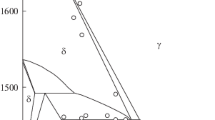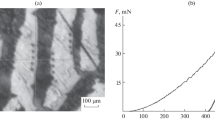Abstract
The temperature dependence of the kinematic viscosity, electrical resistivity, surface tension, and density of liquid steels and alloys on heating and subsequent cooling is analyzed. On that basis, the polytherms of the physical properties of steels and alloys are systematized. On heating to certain critical temperatures, changes occur in the structure of the melt. Consequently, the cooling polytherms take a form more closely resembling the equilibrium classical laws and do not match the heating polytherms. Branching or hysteresis of the temperature dependences is only irreversible on heating to critical temperatures. Otherwise, partial or complete return to the primary melt structure is possible. That affects the degree of hysteresis of the polytherms. The degree of hysteresis and the data regarding the properties provide qualitative information regarding the transition of the melt structure from the equilibrium to the microhomogeneous state. The uniformity of the distribution of atoms of the alloying elements in microgroupings or clusters indicates the equilibrium of the structure, while the uniformity of the distribution of clusters that differ in structure over the melt volume reflects structural microhomogeneity. Data on the properties of multicomponent metals indicate that, after melting, the variation in melt properties on isothermal holding takes the form of familiar damping oscillations. With increase in temperature, the damping becomes aperiodic, and the relaxation time declines. The processes responsible for the isothermal variation in melt properties occur at the microscopic level. Nonequilibrium industrial metal usually contains inclusions inherited from the initial materials, such as insoluble graphite particles in the cast iron or associations and aggregations of carbide and nitride type. The melt takes a long time to reach equilibrium—usually longer than the time for diffusional mixing of the atoms within the nonequilibrium regions. With more complex chemistry and structure of the solid metal, the distance of the melt from equilibrium will be greater. In this system, new correlations are formed and broken more intensely. Cooperative interactions of the new spatial and time structures with those inherited from the initial materials occur here, as indicated by oscillating behavior of the properties of the metallic melts. Information regarding the state of the melt before solidification permits scientific analysis of the melting points and melting times of the steels and alloys. Such preparation of the melt affects its supercooling, its solidification rate, the formation of hardening phases and eutectics, the segregation of the elements, the dendrite and zonal; structure of the castings, and the overall product quality and production efficiency.
Similar content being viewed by others
References
Elanskii, G.N., Minchevskii, B.V., and Kal’menev, A.A., Osnovy proizvodstva i obrabotki metallov (Fundamentals of Production and Processing of Metals), Moscow: Mosk. Gos. Vechern. Metall. Inst., 2005.
Elanskii, G.N., Stal’ i periodicheskaya sistema elementov D.I. Mendeleeva (Steel and Mendeleev’s Periodic Table of the Elements), Moscow: Mosk. Gos. Vechern. Metall. Inst., 2011.
Tsong, T.T., Atom-Probe Field Ion Microscope, Cambridge: Cambridge Univ. Press, 1990.
Miller, M., Cerezo, A., Hetherington, M., and Smith, G., Atom-Probe Field Ion Microscope, Vol. 52: Monographs on the Physics and Chemistry of Materials, Oxford: Oxford Univ. Press, 1996.
Miller, M., Atom-Probe Tomography, New York: Springer-Verlag, 2000.
Michael, K., Miller, M., and Richard, G., Forbes Atom- Probe Tomography the Local Electrode Atom-Probe, New York: Springer-Verlag, 2014.
Larson, D.J., Prosa, T.J., Ulfig, R.M., Geiser, B.P., and Kelly, T.F., Local Electrode Atom-Probe Tomography a User’s Guide, New York: Springer, 2013.
Kellogg, G.L., Measurement of activation energies for field evaporation of tungsten ions as a function of electric field, Phys. Rev. B, 1984, vol. 29, no. 8, pp. 4304–4312.
Wada, M., On the thermally activated field evaporation of Surface atoms, Surf. Sci., 1984, vol. 145, pp. 451–465.
Menand, A. and Blavette, D., Temperature dependence of iridium field evaporation rate, J. Phys. C, 1986, vol. 47, no. 7, pp. 17–20.
Saxey, D.W., Correlated ion analysis and the interpretation of atom probe mass spectra, Ultramicroscope, 2011, vol. 111, no. 6, pp. 473–479.
Shaburova, N.A., Theory and practice of using external actions for melts processing, Vestn. Yuzh.-Ural. Gos. Univ., Ser. Metall., 2013, vol. 13, no. 1, pp. 85–90.
Tsepelev, V.S., Konashkov, V.V., Baum, B.A., Tyagunov, G.V., and Baryshev, E.E., Svoistva metallicheskikh rasplavov (The Properties of Metal Melts), Yekaterinburg: Ural. Gos. Tekh. Univ., 2008, in 2 parts.
Baryshev, E.E., Tyagunov, A.G., and Stepanova, N.N., Vliyanie struktury rasplava na svoistva zharoprochnykh nikelevykh splavov v tverdom sostoyanii (Effect of Melt Structure on the Properties of Heat Resistant Solid Nickel Alloys), Yekaterinburg: Ural. Otd., Ross. Akad. Nauk, 2010.
Tyagunov, G.V., Baryshev, E.E., and Tsepelev, V.S., Zhidkii metal. Poroshki (Liquid Metal. Powders), Yekaterinburg: Ucheb.-Metod. Tsentr, Ural. Politekh. Inst., 2014.
Petrushin, N.V. and Svetlov, I.L., Physical-chemical and structural parameters of high-temperature nickel alloys, Metally, 2001, no. 2, pp. 63–73.
Elanskii, G.N. and Elanskii, D.G., Stroenie i svoistva metallicheskikh rasplavov (Structure and Properties of Metal Melts), Moscow: Mosk. Gos. Vechern. Metall. Inst., 2006.
Zuev, M.V., Burmasov, S.P., Stepanov, A.I., Gudov, A.G., Murzin, A.V., and Zheltukhin, E.G., Improvement in steel smelting by studying melt behavior, Steel Transl., 2013, vol. 43, no. 2, pp. 106–109.
Polishchuk, A.D. and Polishchuk, D.A., Kompleksnoe otsenivanie v sistemnykh issledovaniyakh (Complex Evaluation in System Studies), Varna, 2013, vol. 1, pp. 368–370.
Kolotukhin, E.V., Improvement of the technology of smelting and improvement of the quality of high-temperature alloys on the basis of studies of their electrical resistivity, in Svoistva metallicheskikh rasplavov (The Properties of Metal Melts), Yekaterinburg: Ural. Gos. Tekh. Univ., 2008, part 2, pp. 113–122.
Li, P., Mi, C., Okhapkin, A.V., Konstantinova, N.Y., Sabirzianov, A.A., and Popel, P.S., Micro-mechanism for the evolution of viscosity versus temperature in magnesium-aluminum alloy melts, Procedia, 2012, vol. 27, pp. 871–879.
Beltyukov, A.L., Menshikova, S.G., and Ladyanov, V.I., The viscosity of binary Al–Fe melts in the Al-rich area, J. Non-Cryst. Solids, 2015, vol. 410, pp. 1–6.
Tret’yakova, E.E., Optimization technology of smelting and improvement of the quality of chromium steels based on analysis of the surface tension of their melts, Extended Abstract of Cand. Sci. (Tech.) Dissertation, Sverdlovsk: Ural. Politekh. Inst., 1986.
Popel’, P.S., Metastable micro-heterogeneity of melts in systems with eutectic and monotectic and its effect on the alloy structure after solidification, Rasplavy, 2005, no. 1, pp. 22–48.
Popel, P.S., Chikova, O.A., and Matveev, V.M., Metastable colloidal states of liquid metallic solutions, High Temp. Mater. Process., 1995, vol. 14, no. 4, pp. 219–234.
Brodova, I.G., Popel, P.S., and Eskin, G.I., Liquid Metal Processing: Applications to Aluminium Alloy Production, London: Taylor and Francis, 2002.
Author information
Authors and Affiliations
Corresponding author
Additional information
Original Russian Text © A.G. Tyagunov, E.E. Baryshev, G.V. Tyagunov, V.S. Mushnikov, V.S. Tsepelev, 2017, published in Izvestiya Vysshikh Uchebnykh Zavedenii, Chernaya Metallurgiya, 2017, No. 4, pp. 310–317.
About this article
Cite this article
Tyagunov, A.G., Baryshev, E.E., Tyagunov, G.V. et al. Polytherms of the physical properties of metallic melts. Steel Transl. 47, 250–256 (2017). https://doi.org/10.3103/S096709121704012X
Received:
Published:
Issue Date:
DOI: https://doi.org/10.3103/S096709121704012X




